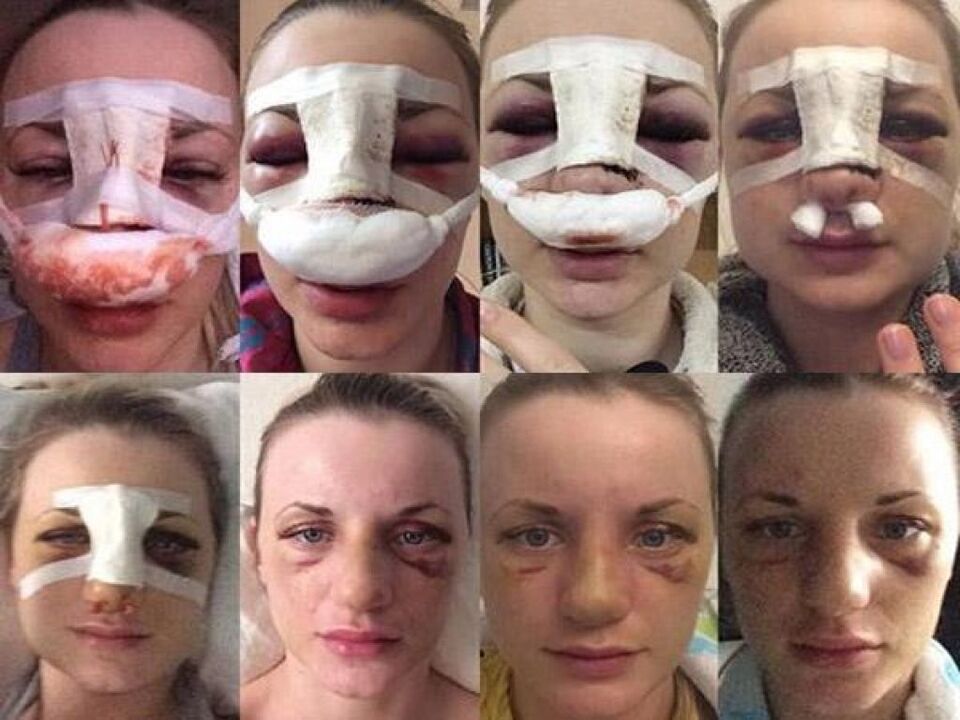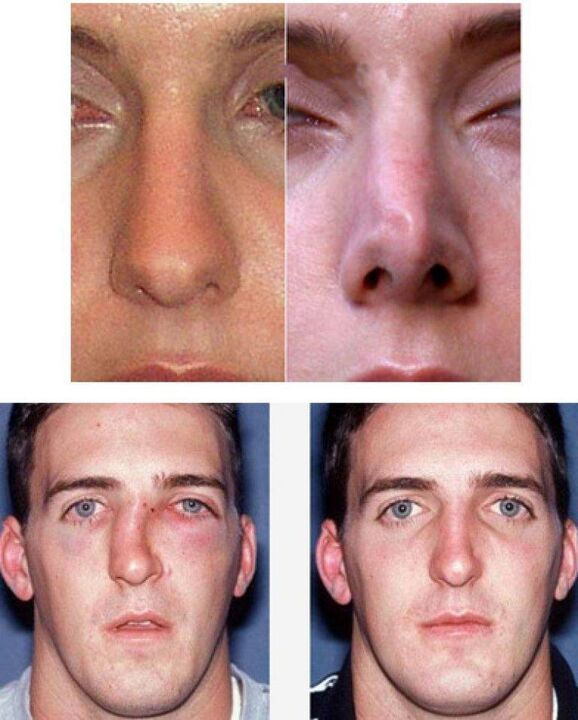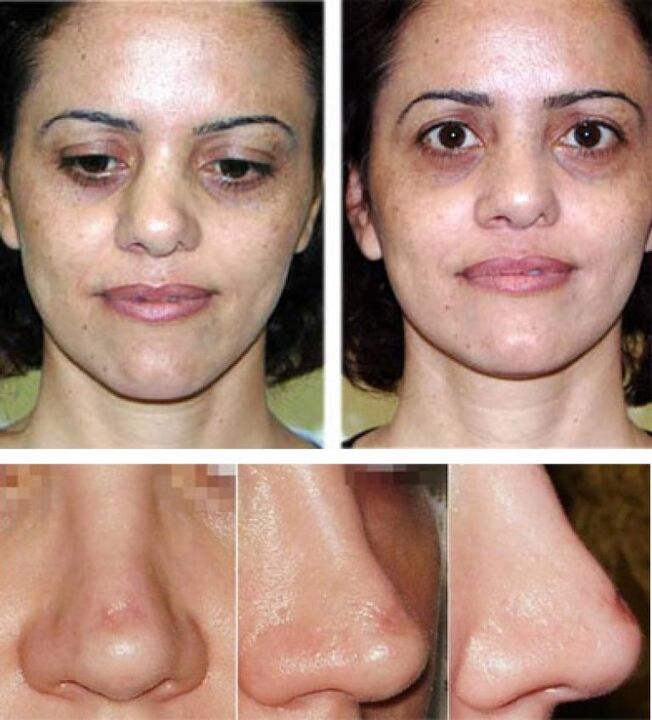Rhinoplasty is considered an important surgical procedure. The result after a rhinoplasty is often not always what we want. And that already requires a second operation. A rhinoplasty is considered unsuccessful if it did not produce the desired effect or if it made the patient's condition worse. It should be treated very responsibly. Incorrect correction of the shape of the nose, loss of smell, curvature of the nasal septum and difficulty breathing can cause excessive swelling. Therefore, before rhinoplasty surgery, you need to be aware that the result may differ from what you want.

Possible complications
Unfortunately, it is quite difficult to predict how rehabilitation will go. Even the most experienced doctor will not be able to tell exactly how the body will react. Hence, it is believed that plastic is a jewelry work and that rhinoplasty is filigree. The consequences of an operation can be irreversible and in preparation for such an operation, all possible risks should be sensibly assessed.
The most likely side effects of a nose job are:
- Bleeding from the nose;
- Hyperpigmentation at the exposure site;
- Disorders of the lymphatic and blood flow, which lead to the formation of edema and hematoma;
- Abscesses;
- Bleeding in the operated and approximate areas;
- complete or partial loss of smell;
- Difficulty breathing due to swelling of the mucous membranes;
- Curvature of the nasal septum;
- excessive formation of scar tissue, which ensures the formation of a voluminous scar;
- Inflammatory process in soft tissues.
The appearance of the above characters indicates an unsuccessful operation.
Causes of complications
Knowing about the possible causes of complications after plastic surgery and how to prevent them is much easier and safer for the body.
Lack of experience
The most common prerequisite for side effects of a nose job is a low level of qualification on the part of the surgeon. Insufficient experience leads the doctor to ignore certain mandatory points. In addition, it can be influenced by poor development of practical skills. They are especially important in rhinoplasty. The nose has a very complex structure and the smallest mistake, any wrong movement can have irreversible consequences.
Wrong choice of technique
An inexperienced doctor doesn't have to be wrong. Experienced surgeons make mistakes too, and that happens far more often than we'd like. This is because there are several techniques for rhinoplasty surgery. Each of them are most optimal for use on patients with specific anatomical features according to the desired goals. Also, the wrong choice of technique in nose plastic surgery can lead to serious results, which in most cases cannot be eliminated.
Disorders in postoperative care
Successful plastic surgery is only half the positive outcome. The second part falls into the recovery phase. The patient's behavior at this point will be of great importance. Failure to comply with medical recommendations leads to the appearance of edema, hematoma and active scarring of tissues. A doctor who performs plastic surgery can usually get an accurate picture of how rehabilitation will go and tell you what resources can be used to reduce it.
Patients often neglect the advice of a specialist prior to plastic surgery based on friends' experiences or their own subjective feelings. And the result of this attitude is a deterioration in the condition, the appearance of pigmentation, swelling that does not go away, and other unpleasant side effects that are characteristic of unsuccessful nasal surgery.

How can complications be avoided?
Everyone would rather prevent a problem than solve it. In the case of a rhinoplasty, this is an absolutely and completely correct decision. Minimizing risks not only helps to achieve the highest quality result. It allows to avoid the occurrence of side effects and makes recovery as easy as possible.
- Choosing a doctor and a clinic. It is best to choose the specialist whose "portfolio" gives you the opportunity to "get to know" each other live. This will help see how well he can embody the desires of the patients to form an overall picture of professionalism. In addition, you can read the reviews of those who performed a nose job in the selected clinic and by a specific doctor. To do this, you need to spend some time trying to find information about the surgeon and anesthetist in the reviews. When making your selection, you shouldn't just be guided by reviews on the "native" site - these are usually moderated and not all of them can be published. An excellent result is shown by visual photos before and after the rhinoplasty.
- Build the most accurate project. In order for the surgeon to better understand what the patient wants, modern medicine uses computer-aided design. Having set the basic parameters of the face, the program allows you to come closest to natural correction. This allows a person to see how satisfied they will be with the expected result of the nasal surgery. The doctor, for his part, will be able to assess the possibility of implementation and, if necessary, suggest alternative options. However, it should be borne in mind that such a design cannot always take into account all anatomical features, and therefore cannot guarantee complete compliance with the desired result.
- Strict adherence to the recommendations before and after plastic surgery. Contrary to popular belief, preparation for the procedure is very important. It helps determine the degree of scarring during remission and predict the development of hematoma and edema. Therefore, before undergoing any rhinoplasty surgery, it is a good idea to consult your doctor and carefully follow all his or her advice. Post-operative care minimizes side effects by reducing pain, swelling and scarring after the rhinoplasty.

The result will be fully visible after 6-8 months. Until then, small swellings and edema may appear and go away at regular intervals. Before the appointment, you shouldn't panic - lymph flow and blood circulation are not restored immediately and therefore side effects can occur for a period of time after a nose job.

Re-correction
After plastic surgery, patients sometimes want to correct the shape of their nose. This will make it possible, if possible, to restore the injuries that were noted while performing an unsuccessful plastic.
This procedure has a number of complexities. A new operation after an unsuccessful rhinoplasty is in most cases much more serious than the first. At this point in time, the shape of the nose is corrected from the amount of tissue available. And this can make the surgeon's job much more difficult. Such a rhinoplasty by no means guarantees the full achievement of the desired result. Therefore, you should consult several doctors first.
If the patient has minor defects, a corrective rhinoplasty is carried out. It is performed under local anesthesia and can be nothing more than an adaptation to a completely finished version. Typically this includes nasal tip rhinoplasty and scar tissue removal.

Non-surgical correction is performed even without major violations after an unsuccessful operation. It is performed under local anesthesia and may contain fillers. They help to "fill in" the depressions and irregularities that have formed, emphasize the cartilage and correct the angles.
The contouring also aims to delicately correct the details of the nose. Hyaluronic acid is used, which forms a special "framework" for skin and tissue. With its help, it is possible to correct details, angles and asymmetry of the nose.
General recommendations
- Rhinoplasty is a very serious and responsible step. When agreeing to an operation, one must be aware that it is impossible to restore everything to its previous state. Therefore, it is very important to have psychological readiness to perform the procedure and to wait six months for the final result, until the edema has completely disappeared.
- Choosing a clinic and a surgeon plays a very important role in performing high quality nasal surgery. Before going to an appointment, it is worth reading the reviews on the network. The more information that can be found before a rhinoplasty, the easier it will be to make a decision. You shouldn't focus on loud advertising - this often hides low professionalism, a multitude of additional mandatory paid services and not the best attitude towards customers.
- During the initial consultation, you should try to describe the desired result of the plastic surgery to the doctor as precisely as possible. This will help him navigate better and create a "work front". The surgeon's understanding of the desired result will help achieve it most accurately. It is likely that a conventional rhinoplasty is more likely than a full-fledged procedure.
- In any case, an experienced surgeon will clarify whether you have breathing problems, allergic reactions, previous illnesses and any medication you have taken. This helps to create as complete a clinical picture as possible, on the basis of which drugs and influencing methods can be selected during the rhinoplasty. It is worth noting that if a doctor does not provide such information, this is a very alarming sign for low-skilled specialists.






















